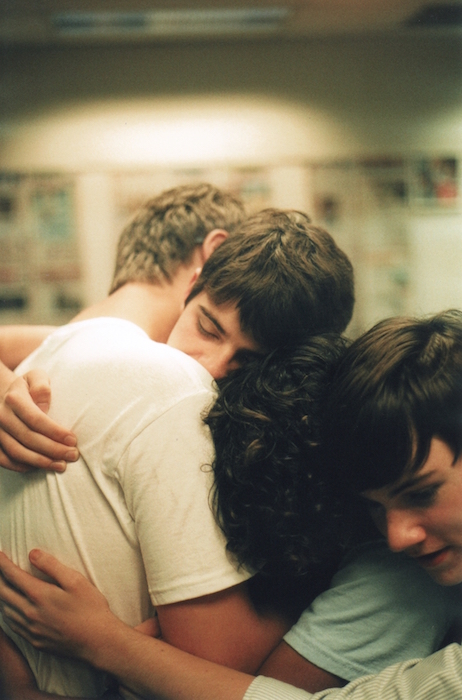As the daughter of a Jewish mother and a Norwegian father, there were two distinct kinds of hugs when I was a kid.
There was the bone crushing embrace of my Bubbe, which was accompanied by a series of kisses literally smacked onto my cheek, forehead, and (if aimed poorly) eyelid, with lips pursed over clenched teeth just dying to go ahead and sneak a bite of me, as if I were an irresistible piece of chocolate babka.
Visits to the other side of the family concluded in a much different display of affection. Standing by the door as we left, Grandma Dagny would stiffen her body like a wooden board and lean slightly in my direction, arms by her side. She would awkwardly turn her cheek out to field any potential kisses, lest she should make lip contact with me. She was not a cold woman, quite the opposite, but her warmth was expressed through coffee and conversation, not through physical contact. Uff da.
Very Scandinavian.
One of the most epically defining experiences of my childhood involved a hug. When I was six or seven years old, my family had a green and yellow pet parakeet. Barnie liked to walk around on the kitchen floor like a dog, catching crumbs and hitching an occasional ride on a passing foot.
One day after school, my father and I were rushing around making a snack on the way out to my ballet class. I was in my black leotard and brown leather sandals—the ones we got on vacation in Cape Cod from a real leathersmith, with big flat waffle-patterned rubber soles. I cannot report the detailed logistics of how it happened. It was sudden, and it was shocking. I stepped on Barnie.
I felt him crunch under my foot.
What I saw and heard is permanently seared in my memory. In fact tears roll down my cheeks as I write this now, so many years later. Barnie was immobilized on the floor with his back broken. His head and tail were intact, but he was flattened in the middle where my foot had been.
The worst is that he wasn’t dead. Hardly. He was frantically squawking in pain he tried to get up. Recognizing there was no way to help him, my father knelt down and took me in his arms. Safe in the sheltered world of my father’s embrace, I buried my face in his shoulder and sobbed just a few feet from our suffering pet while we waited for him to finally die.
I didn’t go to ballet that day. My father made me change my shoes. In fact, he had me permanently retire them. Seeing the blood and feathers adhered to the waffle-patterned rubber, was enough to warrant their permanent disposal. He made sure I knew it wasn’t my fault and took me for an ice cream to soothe my aching heart.
In the libidinous teenage years, and followed by early adulthood, I didn’t think much about hugging. The need for physical affection was eclipsed by—or perhaps entangled with—sexual expression. In search of the perfect French kiss, I could make out for hours. Exploring the feeling of a man inside me was like a space expedition. How could I think of a simple road trip like hugging when NASA was launching a rocket to the moon?
It wasn’t until my daughter was born in my early 30’s that I became reacquainted with the importance of hugging.
Any woman who has had a baby is familiar with the bizarrely wondrous feeling of having a human being growing inside her body. And by the time it’s time to give birth, the transition from inside to outside brings a mix of relief and loss. It’s curious what the experience is like for the baby. A 40-week human pregnancy is broken into three trimesters of roughly three months each. I have heard the first three months of an infant’s life referred to as the fourth trimester.
In the earliest days after birth, we replace the warm, tight containment of the womb with the swaddling of a blanket.
In fact, the basic ways we soothe our babies are rooted in mimicking the conditions in utero. We cradle them in our arms, holding them tightly to our chest, where they can hear our hearts beating and feel surrounded…contained…held. In the land of the living, our first language is hugging.
I love hugs. I give good hug.
In fact, I consider hugging a practice, a healing modality, a form of meditation.
As a blissfully single woman who just recently turned 50, I rarely am at a loss for a lover. But what I truly crave more often than sex, is a long, quality hug—the kind you sink into so long you forget that you are actually two people.
I asked my 972 Facebook friends, recently, what they love about hugs. The responses were plentiful, and all about safety, warmth, comfort, security, heartbeats, connection to each other, and connection through each other to Source or Oneness. To me that sounds a lot like the bonding that happens at the dawn of our consciousness.
Our love of a proper hug is not superficial or silly. It speaks to our need for the kind of existential homeostasis programmed in early infancy, or reaching even further back in the tight embrace of our mother’s womb, when two bodies were actually one.
As my colleague, Bryan Reeves, so eloquently states in his article, The Eightfold Path to a Truly Great Hug, “A truly great hug is a rich experience that has you pull another human body deliciously tight into yours as a way of saying, “I so deeply value your presence that I’m taking this exact moment to feel you, smell you, breathe with you—essentially stamp your being into my cellular memory so that even though we may be soon part, you will in fact always be with me in the living fabric of my existence.”
Consider this article an invitation to join me in bringing deep healing to someone by giving them a truly great hug.
Reset their nervous system. Allow them to dissolve into pure existence, where no thought exists and our only requirement is to surrender to a loving embrace as a pathway to connection to a source even greater than our mother.
Let’s make this our practice. You know—saving the world one hug at a time.



Read 9 comments and reply